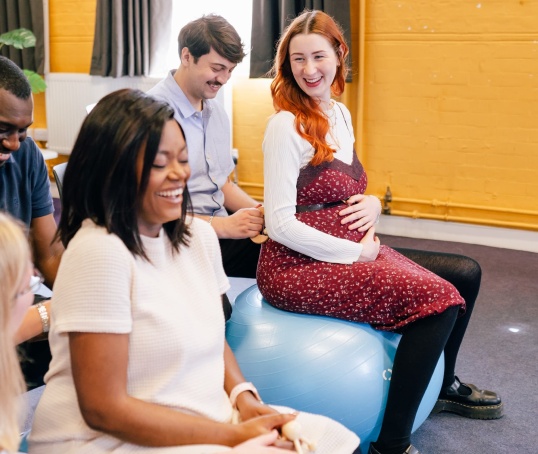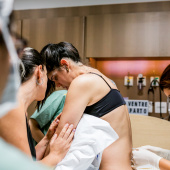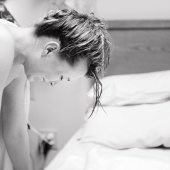Learn about water birth and what to consider if you want to use water and a birthing pool during labour.
What is a water birth?
A water birth is when a baby or babies are born in water. It is different to labouring in water and getting out of the pool to give birth.
The birth of the placenta (third stage of labour) can also happen in or out of the water (Decker, 2024).
Who can have a water birth?
Every pregnant woman and birthing person has the right to ask for and have a water birth and should be offered the option to labour in water (NICE, 2025).
If a midwife or obstetrician has concerns, they should respectfully discuss the risks and benefits so that expectant parents can make their own informed decision.
The hospital or birth centre might discourage water birth if there is a clear medical reason. If this happens, they should explore other options with the woman or birthing person, such as using water during labour only (Birthrights, no date).
We explore different options for birth and how to advocate for yourself or someone’s maternity care in our NCT Antenatal Course.
What are the benefits of water birth?
A water birth can be an empowering experience for those who decide it’s right for them. Labouring in water can be associated with feelings of relaxation, privacy, and control. It is also a recognised pain management tool (Reviriego-Rodrigo et al, 2023; Ulfsdottir et al, 2018). Of course, every labour is different, and some people may find water birth isn’t right for them.
The benefits of using water in labour include (Reviriego-Rodrigo et al, 2023):
- Relaxation and decreased anxiety
- Sense of comfort and well-being
- Pain management
- Increased ability to move
- Less chance of perineal tearing
- Shorter labour (active phase)
- Reduced need for other pain management, such as epidural
- Reduced likelihood of a vaginal birth with forceps or ventouse, or an episiotomy
Is a water birth safe for babies?
Research shows waterbirths are generally safe for both parent and baby. Birth pools in hospitals or birth centres are cleaned regularly and thoroughly to prevent infection (NICE, 2025).
The largest and most recent UK-based study of labouring in water found babies didn’t need any more extra care after birth, compared to when a woman or birthing person didn't use water (Sanders et al, 2024).
The study did find higher rates of umbilical cord snapping before clamping during waterbirth. This was uncommon (1 in every 100 births, compared to 1 in every 300 births out of water).
Researchers looked at the risks of the cord snapping if the baby is lifted out of the water too quickly, or if the umbilical cord is short. It can be managed by bringing the baby up slowly or lowering the water level before birth, so the cord isn’t stretched too far. If the cord snaps, the midwife or doctor will clamp it immediately (Schafer, 2014).
Giving birth in water may have a diluting effect on the bacteria babies acquire from the birth canal (microbiome), compared to babies born vaginally out of water. Researchers say the microbiome difference appears to be temporary, but it may still have some influence on how the baby’s immune system develops (Rapin et al, 2023).
Where are water births available?
Water births can happen at home, in midwife-led units, or on hospital labour wards, depending on local availability.
If giving birth at home, a birthing pool will usually need to be hired privately.
Find out more about deciding where to give birth.
What else can impact the ability to have a water birth?
There are some factors that may impact a woman or birthing person’s ability to have a water birth. These include (Milosevic et al, 2019):
- Availability: Access to birth pools can be limited in birthing centres and labour wards. It often works on a first-come, first-served basis. This can be stressful if it’s an important part of a someone’s birth plan (Milosevic et al, 2019).
- Location: Birth pools are more common in midwife-led units than labour wards. Ask about access in advance. Hiring or buying a pool to use at home is also an option.
- Equipment: When deciding where to give birth, check what equipment is available to support a waterbirth. For example, in hospitals, a lack of wireless monitoring (CTG) equipment may be a barrier to pool use.
- Timing: Depending on the size of the birthing pool, it can take around 45 minutes to fill in a birth centre or labour ward, and up to two hours to fill up at home. If giving birth at home, it is a good idea to start filling up the pool in the early stages of labour.
- Staff preference: Some health professionals may be reluctant to offer water births if they have limited experience, especially in obstetric (hospital) units (Sanders et al, 2024; Milosevic et al, 2019).
- Inequalities: Research shows that white women from higher socioeconomic backgrounds are more likely to have a water birth (Sanders et al, 2024; Aughey et al, 2021). Cultural barriers can affect access. Talk to a midwife during pregnancy if this is part of your plan (Sanders et al, 2024; Aughey et al, 2021).
Remember, everyone has the right to access a water birth if they want one. If you’re told you can’t, ask for a discussion about the risks and benefits so you can make an informed decision (Birthrights, no date).
What if the women or birthing person or the baby has other medical needs?
Evidence shows it can be difficult for women or birthing people to have a water birth if they have other medical needs (Milosevic et al, 2019).
For example, midwives and doctors might discourage a person from labouring in water if they have a high Body Mass Index (BMI). This happens even though labouring in water has been proven to increase weightlessness, comfort, and the ability to move around and float (Kerrigan et al, 2015; Hollowell et al, 2013; HSE, 2018).
If a woman or birthing person has other medical needs, it is still possible to request and have a waterbirth or to use water in labour for pain management. Any concerns should be discussed with a midwife or doctor during pregnancy.
What else is there to know about when labouring in water?
A woman or birthing person can stay in the birthing pool as long as they wish and get in or out whenever they want. A birth partner or midwife can help if needed.
Water temperature: The temperature of the water in a birthing pool should not be above 37.5 degrees. A midwife will also check the temperature of the woman or birthing person during labour to ensure they are comfortable and not getting too hot (NICE, 2025).
Hydration: Staying hydrated while in labour is important. Make sure there are plenty of cool drinks available.
Birthing partners: A birth partner can also get into the birthing pool if invited. However, they will need to wear suitable clothing.
Midwife checks: Midwives can carry out checks while a woman or birthing person is labouring in the water. They will have waterproof equipment, such as a foetal monitor (doppler) to track the baby’s heartbeat and a mirror to check the baby as they are being born.
We support parents to prepare for labour and birth, wherever and however they plan to do it, as part of our NCT Antenatal Course. Explore our course content and book a local antenatal class here. Explore our course content and book a local antenatal class here.
Are other pain management options available during a water birth?
Giving birth in water can reduce the need for other pain management (Reviriego-Rodrigo et al, 2023).
However, a woman or birthing person can access Entonox (gas and air) whilst in a birthing pool.
TENS machines and opioids like pethidine can’t be used in water. It isn’t possible to have an epidural either. It's okay to get out of the water to access these options.
In most cases, these pain management options can be used in combination with labouring in water, just not at the same time. For example, if pethidine has been administered, a midwife will need to confirm that it has passed out of the woman or birthing person’s system before they get into water, usually after a few hours.
What happens when a baby is born in water?
A baby’s first breath: If a baby is born in the water, they will be gently lifted to the surface by a parent, birth partner, or midwife. Babies don’t breathe until they meet the air and continue to get oxygen through the umbilical cord.
Skin-to-skin: A baby can remain in the water for skin-to-skin contact and to start breastfeeding or chestfeeding if the woman or birthing person wants to.
Giving birth to the placenta: A woman or birthing person can decide if they want to stay in the water to give birth to their placenta (third stage of labour). Research shows that among those who used water during labour, spontaneous vaginal birth of the placenta was more common - nearly 3/10 compared to 1/10 for births out of water (Sanders et al, 2025). Birthing the placenta in water can also facilitate skin to skin contact that might be disrupted by getting out of the pool. This does not increase chances of bleeding after birth (postpartum haemorrhage) (Sanders et al, 2025).
Find out more about what happens immediately after a baby is born.
What are the reasons to get out of the birthing pool?
There are many reasons a woman or birthing person may want to get out of the birthing pool, and they can do this at any time. For example, wanting to be more active, needing to use the toilet, or feeling uncomfortable.
A midwife might ask the person in labour to get out of the water for a vaginal examination, but they don’t have to.
If there are any complications, a midwife may recommend getting out of the birthing pool. These might include if (NHS Lanarkshire, 2020):
- The baby is distressed
- There is some blood loss
- The woman or birthing person has a high temperature
- The woman or birthing person has high blood pressure
- There’s a delay or slowing down of the first stage of labour
- There’s a delay in the second stage of labour (pushing stage)
If meconium (the baby’s first poo) is seen in the water, the midwife might suggest transferring to a hospital labour ward (if at home or in a birth centre) so that the baby can be monitored more closely. This might also be a reason for getting out of the pool (NICE, 2025).
What other pain management options are available during labour?
To learn about other pain management options read our articles on:
- Using a TENS machine
- Gas and air (Enotox)
- Epidurals
- Intramuscular opioids (Pethidine/ Diamorphine)
- Remifentanil
- Sterile water injections
Need more information?
Every woman and birthing person has the right to feel safe, informed, supported, and confident about their decisions.
For further information, we offer NCT antenatal courses which are a great way to prepare for pregnancy, birth, and life with a new baby.
Our NCT support line also offers practical and emotional support with feeding your baby and general enquiries for parents, members and volunteers: 0300 330 0700.
Aughey, H., Jardine, J., Moitt, N. et al. (2021) Waterbirth: a national retrospective cohort study of factors associated with its use among women in England. BMC Pregnancy Childbirth 21, 256 https://doi.org/10.1186/s12884-021-03724-6 [Accessed November 2025]
Birthrights (no date) Choice of place of birth https://birthrights.org.uk/factsheets/choice-of-place-of-birth/#birthcentrechoice [Accessed November 2025]
Hollowell J, Pillas D, Rowe R, Linsell L, Knight M, Brocklehurst P. (2013) The impact of maternal obesity on intrapartum outcomes in otherwise low risk women: secondary analysis of the Birthplace national prospective cohort study. BJOG 121: 343–355. [Accessed November 2025]
HSE (2018) Manual handing risks to midwives associated with birthing pools: literature review and incident analysis. https://webarchive.nationalarchives.gov.uk/ukgwa/20241206175108/https:/… [Accessed November 2025]
Kerrigan, A., Kingdon, C. & Cheyne, H. (2015) Obesity and normal birth: A qualitative study of clinician’s management of obese pregnant women during labour. BMC Pregnancy Childbirth 15, 256. https://doi.org/10.1186/s12884-015-0673-2 [Accessed November 2025]
NHS Lanarkshire (2020) Guideline for the management of waterbirth. https://rightdecisions.scot.nhs.uk/media/1950/waterbirth-april-2020.pdf [Accessed November 2025]
NICE (2025) NG235 Intrapartum care https://www.nice.org.uk/guidance/ng235/chapter/Recommendations#pain-relief-during-labour [Accessed November 2025]
Milosevic, S., Channon, S., Hunter, B., Nolan, M., Hughes, J., Barlow, C., Milton, R. & Sanders, J. (2019) Factors influencing the use of birth pools in the United Kingdom: Perspectives of women, midwives and medical staff. Midwifery Vol. 79:102554 https://www.sciencedirect.com/science/article/pii/S0266613819302451?via%3Dihub [Accessed November 2025]
Rapin, A., Rehbinder, E. M., Macowan, M., Pattaroni, C., Lødrup Carlsen, K. C., Harris, N. L., Jonassen, C. M., Landrø, L., Lossius, A. H., Nordlund, B., Rudi, K., Skjerven, H. O., Cathrine Staff, A., Söderhäll, C., Ubags, N., Vettukattil, R., & Marsland, B. J. (2023). The skin microbiome in the first year of life and its association with atopic dermatitis. Allergy, 78(7), 1949–1963. https://doi.org/10.1111/all.15671 [Accessed November 2025]
RCOG (2017) Prevention of Early-onset Neonatal Group B Streptococcal Disease https://www.rcog.org.uk/guidance/browse-all-guidance/green-top-guidelines/prevention-of-early-onset-group-b-streptococcal-disease-green-top-guideline-no-36/ [Accessed November 2025]
Reviriego-Rodrigo, E., Ibargoyen-Roteta, N., Carreguí-Vilar, S. et al. (2023) Experiences of water immersion during childbirth: a qualitative thematic synthesis. BMC Pregnancy Childbirth 23, 395 https://doi.org/10.1186/s12884-023-05690-7 [Accessed November 2025]
Sanders, J., Barlow, C., Cannings-John, R., & et al. (2024). Maternal and neonatal outcomes among spontaneous vaginal births occurring in or out of water following intrapartum water immersion: The POOL cohort study. BJOG: An International Journal of Obstetrics & Gynaecology, 131(12), 1650-1659. https://obgyn.onlinelibrary.wiley.com/doi/full/10.1111/1471-0528.17878 [Accessed November 2025]
Schafer, R (2014) Umbilical Cord Avulsion in Waterbirth Journal of midwifery & women's health, 59 (1) https://pubmed.ncbi.nlm.nih.gov/24588881/ [Accessed November 2025]
Ulfsdottir H, Saltvedt S, Ekborn M, Georgsson S. (2018) Like an empowering micro-home: a qualitative study of women’s experience of giving birth in water. Midwifery. 67:26–31. https://www.sciencedirect.com/science/article/abs/pii/S0266613818302778?via%3Dihub [Accessed November 2025]







